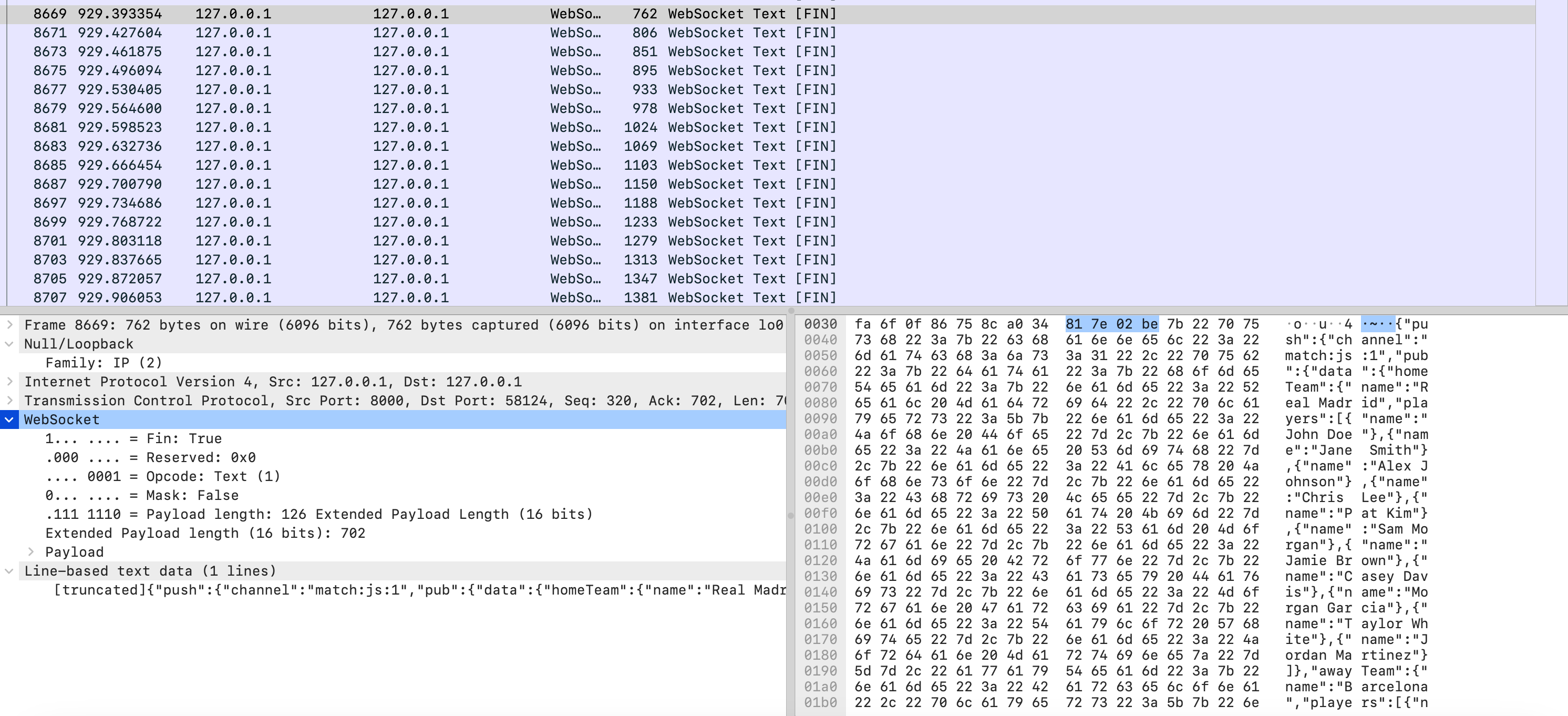Experimenting with real-time data compression by simulating a football match events

Optimizing data transfer over WebSocket connections can significantly reduce bandwidth costs. Compressing data usually leads to memory and CPU resource usage overhead – but in many cases it worth doing anyway since it positively impacts the final bill from the provider (bandwidth cost reduction overweights resource usage increase).
Centrifugo v5.4.0 introduced delta compression feature. But before implementing it we wanted a playground which could demonstrate the potential benefit of using delta compression in Centrifugo channels.
This post outlines our approach to estimating the potential profit from implementing delta compression. It demonstrates the reduction in data transfer using once concrete use case across various configurations, including different Centrifugo protocol formats and the additional use of WebSocket permessage-deflate compression. Although these numbers can vary significantly depending on the data, we believe the results are valuable for providing a general understanding of Centrifugo compression options. This information can help Centrifugo users apply these insights to their use cases.
About delta compression

For a good overview of delta compression topic for the real-time messaging applications I suggest starting with a blog post in Ably engineeiring blog.
Centrifugo is very similar to Ably in many aspects (though self-hosted), so everything said in the linked post equally applies to Centrifugo use cases too. Though we have differences in the final implementation, one notable is that we are using Fossil delta algorithm in Centrifugo instead of VCDIFF. The reason over VCDIFF was mainly two factors:
- availability of several Fossil delta implementations, specifically there are good libraries for Go (see shadowspore/fossil-delta), and for Javascript - fossil-delta-js.
- the compactness of the algorithm implementation – under 500 lines of code in JavaScript
The compactness property is nice because there are no OSS Fossil implementations for Java, Dart and Swift – languages we have SDKs for – so we may have to implement this algorithm in the future ourselves.
Having said this all, let's proceed to the description of experiment we did to understand possible benefits of various compression techniques, and delta compression in particular.
Experiment Overview
In the experiment, we simulated a football match, sending the entire game state over a WebSocket connection upon every match event. Our compression playground looks like this:
It visualizes only the score, but under the hood there are other game changes happen – will be shown below.
We tested various configurations to evaluate the effectiveness of data compression if different cases. In each setup the same game data was sent over the wire. The data then was captured using WireShark with the filter:
tcp.srcport == 8000 && websocket
This is how WebSocket packets look in Wireshark when applying a filter mentioned above:

Bytes captured show the entire overhead from packets in the game channel going from server to client (including TCP/IP overhead).
The source code of the experiment may be found on Github as a Centrifuge library example. You can run it to inspect the exact WebSocket frames in each scenario.
To give reader a general idea about data, we sent 30 publications with the entire football game state, for example here is a first message in a match (2 teams, 11 players):
Click to see the data
{
"homeTeam":{
"name":"Real Madrid",
"players":[
{
"name":"John Doe"
},
{
"name":"Jane Smith"
},
{
"name":"Alex Johnson"
},
{
"name":"Chris Lee"
},
{
"name":"Pat Kim"
},
{
"name":"Sam Morgan"
},
{
"name":"Jamie Brown"
},
{
"name":"Casey Davis"
},
{
"name":"Morgan Garcia"
},
{
"name":"Taylor White"
},
{
"name":"Jordan Martinez"
}
]
},
"awayTeam":{
"name":"Barcelona",
"players":[
{
"name":"Robin Wilson"
},
{
"name":"Drew Taylor",
"events":[
{
"type":"RED_CARD"
}
]
},
{
"name":"Jessie Bailey"
},
{
"name":"Casey Flores"
},
{
"name":"Jordan Walker"
},
{
"name":"Charlie Green"
},
{
"name":"Alex Adams"
},
{
"name":"Morgan Thompson"
},
{
"name":"Taylor Clark"
},
{
"name":"Jordan Hernandez"
},
{
"name":"Jamie Lewis"
}
]
}
}
Then we send intermediary states – someone scores goal, gets yellow card, being subsctituted. And here is the end message in simulation (final scores, final events attached to corresponding players):
Click to see the data
{
"homeTeam":{
"name":"Real Madrid",
"score":3,
"players":[
{
"name":"John Doe",
"events":[
{
"type":"YELLOW_CARD",
"minute":6
},
{
"type":"SUBSTITUTE",
"minute":39
}
]
},
{
"name":"Jane Smith"
},
{
"name":"Alex Johnson"
},
{
"name":"Chris Lee",
"events":[
{
"type":"GOAL",
"minute":84
}
]
},
{
"name":"Pat Kim"
},
{
"name":"Sam Morgan"
},
{
"name":"Jamie Brown",
"events":[
{
"type":"SUBSTITUTE",
"minute":9
}
]
},
{
"name":"Casey Davis",
"events":[
{
"type":"YELLOW_CARD",
"minute":81
}
]
},
{
"name":"Morgan Garcia",
"events":[
{
"type":"SUBSTITUTE",
"minute":15
},
{
"type":"GOAL",
"minute":30
},
{
"type":"YELLOW_CARD",
"minute":57
},
{
"type":"GOAL",
"minute":62
},
{
"type":"RED_CARD",
"minute":66
}
]
},
{
"name":"Taylor White",
"events":[
{
"type":"YELLOW_CARD",
"minute":18
},
{
"type":"SUBSTITUTE",
"minute":42
},
{
"type":"SUBSTITUTE",
"minute":45
},
{
"type":"YELLOW_CARD",
"minute":69
},
{
"type":"RED_CARD",
"minute":72
}
]
},
{
"name":"Jordan Martinez",
"events":[
{
"type":"SUBSTITUTE",
"minute":21
},
{
"type":"SUBSTITUTE",
"minute":24
}
]
}
]
},
"awayTeam":{
"name":"Barcelona",
"score":3,
"players":[
{
"name":"Robin Wilson"
},
{
"name":"Drew Taylor",
"events":[
{
"type":"RED_CARD"
},
{
"type":"GOAL",
"minute":12
}
]
},
{
"name":"Jessie Bailey"
},
{
"name":"Casey Flores",
"events":[
{
"type":"YELLOW_CARD",
"minute":78
}
]
},
{
"name":"Jordan Walker",
"events":[
{
"type":"SUBSTITUTE",
"minute":33
}
]
},
{
"name":"Charlie Green",
"events":[
{
"type":"GOAL",
"minute":51
},
{
"type":"GOAL",
"minute":60
},
{
"type":"SUBSTITUTE",
"minute":75
}
]
},
{
"name":"Alex Adams"
},
{
"name":"Morgan Thompson",
"events":[
{
"type":"YELLOW_CARD",
"minute":27
},
{
"type":"SUBSTITUTE",
"minute":48
}
]
},
{
"name":"Taylor Clark",
"events":[
{
"type":"SUBSTITUTE",
"minute":3
},
{
"type":"SUBSTITUTE",
"minute":87
}
]
},
{
"name":"Jordan Hernandez"
},
{
"name":"Jamie Lewis",
"events":[
{
"type":"YELLOW_CARD",
"minute":36
},
{
"type":"SUBSTITUTE",
"minute":54
}
]
}
]
}
}
When we used Protobuf encoding for game state we serialized the data according to this Protobuf schema:
Click to see the Protobuf schema for the game state
syntax = "proto3";
package centrifugal.centrifuge.examples.compression_playground;
option go_package = "./;apppb";
enum EventType {
UNKNOWN = 0; // Default value, should not be used
GOAL = 1;
YELLOW_CARD = 2;
RED_CARD = 3;
SUBSTITUTE = 4;
}
message Event {
EventType type = 1;
int32 minute = 2;
}
message Player {
string name = 1;
repeated Event events = 2;
}
message Team {
string name = 1;
int32 score = 2;
repeated Player players = 3;
}
message Match {
int32 id = 1;
Team home_team = 2;
Team away_team = 3;
}
Results Breakdown
Below are the results of our experiment, comparing different protocols and compression settings:
| Protocol | Compression | Delta | Bytes sent | Percentage |
|---|---|---|---|---|
| JSON over JSON | No | No | 40251 | 100.0 (base) |
| JSON over JSON | Yes | No | 15669 | 38.93 |
| JSON over JSON | No | Yes | 6043 | 15.01 |
| JSON over JSON | Yes | Yes | 5360 | 13.32 |
| -- | -- | -- | -- | -- |
| JSON over Protobuf | No | No | 39180 | 97.34 |
| JSON over Protobuf | Yes | No | 15542 | 38.61 |
| JSON over Protobuf | No | Yes | 4287 | 10.65 |
| JSON over Protobuf | Yes | Yes | 4126 | 10.25 |
| -- | -- | -- | -- | -- |
| Protobuf over Protobuf | No | No | 16562 | 41.15 |
| Protobuf over Protobuf | Yes | No | 13115 | 32.58 |
| Protobuf over Protobuf | No | Yes | 4382 | 10.89 |
| Protobuf over Protobuf | Yes | Yes | 4473 | 11.11 |
Results analysis
Let's now discuss the results we observed in detail.
JSON over JSON
In this case we are sending JSON data with football match game state over JSON Centrifugal protocol.
-
JSON over JSON (No Compression, No Delta) Bytes Sent: 40251 Percentage: 100.0% Analysis: This is a baseline scenario, with no compression and no delta, results in the highest amount of data being sent. But very straightforward to implement.
-
JSON over JSON (With Compression, No Delta) Bytes Sent: 15669 Percentage: 38.93% Analysis: Enabling compression reduces the data size significantly to 38.93% of the original, showcasing the effectiveness of deflate compression. See how to configure compression in Centrifugo, note that it comes with CPU and memory overhead which depends on your load profile.
-
JSON over JSON (No Compression, With Delta) Bytes Sent: 6043 Percentage: 15.01% Analysis: Using delta compression without deflate compression reduces data size to 15.01% for this use case, only changes are being sent after the initial full payload. See how to enable delta compression in channels in Centrifugo. The nice thing about using delta compression instead of deflate compression is that deltas require less and more predictable resource overhead.
-
JSON over JSON (With Compression and Delta) Bytes Sent: 5360 Percentage: 13.32% Analysis: Combining both compression and delta further reduces the data size to 13.32%, achieving the highest efficiency in this category. The benefit is not huge, because we already send small deltas here.
JSON over Protobuf
In this case we are sending JSON data with football match game state over Protobuf Centrifugal protocol.
-
JSON over Protobuf (No Compression, No Delta) Bytes Sent: 39180 Percentage: 97.34% Analysis: Switching to Protobuf encoding of Centrifugo protocol but still sending JSON data slightly reduces the data size to 97.34% of the JSON over JSON baseline. The benefit here comes from the fact Centrifugo does not introduce a lot of its own protocol overhead – Protobuf is more compact. But we still send JSON data as Protobuf payloads – that's why it's generally comparable with a baseline.
-
JSON over Protobuf (With Compression, No Delta) Bytes Sent: 15542 Percentage: 38.61% Analysis: Compression with Protobuf encoding brings similar benefits as with JSON, reducing the data size to 38.61%.
-
JSON over Protobuf (No Compression, With Delta) Bytes Sent: 4287 Percentage: 10.65% Analysis: Delta compression with Protobuf is effective, reducing data to 10.65%. It's almost x10 reduction in bandwidth compared to the baseline!
I guess at this point you may be curious how delta frames look like in case of JSON protocol. Here is a screenshot:

- JSON over Protobuf (With Compression and Delta) Bytes Sent: 4126 Percentage: 10.25% Analysis: This combination provides the best results for JSON over Protobuf, reducing data size to 10.25% from the baseline.
Protobuf over Protobuf
In this case we are sending Protobuf binary data with football match game state over Protobuf Centrifugal protocol.
-
Protobuf over Protobuf (No Compression, No Delta) Bytes Sent: 16562 Percentage: 41.15% Analysis: Using Protobuf for both encoding and transmission without any compression or delta reduces data size to 41.15%. So you may get the most efficient setup with nice bandwidth reduction. But the cost is more complex data encoding.
-
Protobuf over Protobuf (With Compression, No Delta) Bytes Sent: 13115 Percentage: 32.58% Analysis: Compression reduces the data size to 32.58%. Note, that in this case it's not very different from JSON case.
-
Protobuf over Protobuf (No Compression, With Delta) Bytes Sent: 4382 Percentage: 10.89% Analysis: Delta compression is again very effective here, reducing the data size to 10.89%. Again - comparable to JSON case.
-
Protobuf over Protobuf (With Compression and Delta) Bytes Sent: 4473 Percentage: 11.11% Analysis: Combining both methods results in a data size of 11.11%. Even more than in JSON case. That's bacause binary data is not compressed very well with deflate algorithm.
Conclusion
-
WebSocket permessage-deflate compression significantly reduces the amount of data transferred over WebSocket connections. While it incurs CPU and memory overhead, it may be still worth using from a total cost perspective.
-
Delta compression makes perfect sense for channels where data changes only slightly between publications. In our experiment, it resulted in a tenfold reduction in bandwidth usage.
-
Using binary data in combination with the Centrifugo Protobuf protocol provides substantial bandwidth reduction even without deflate or delta compression. However, this comes at the cost of increased data format complexity. An additional benefit of using the Centrifugo Protobuf protocol is its faster marshalling and unmarshalling on the server side compared to the JSON protocol.
For Centrifugo, these results highlighted the potential of implementing delta compression, so we proceeded with it. The benefit depends on the nature of the data being sent – you can achieve even greater savings if you have larger messages that are very similar to each other.
